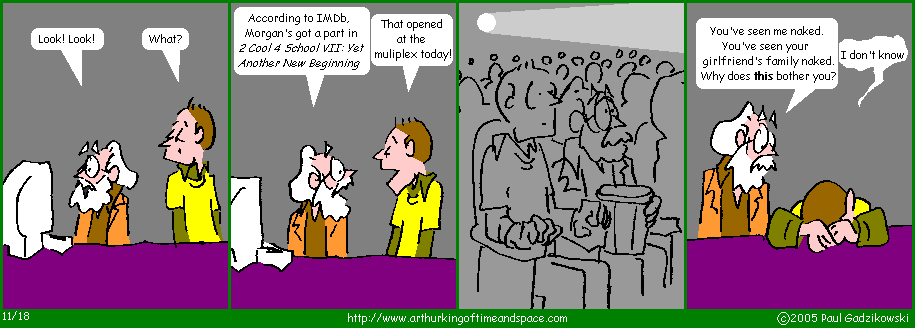recommended resolution 1024 x 768



Thanks for reading.



Thanks for reading.
Paul Gadzikowski
English 120 - Whitney
October 7, 2005
Cultural Activity #1: Eliduc and Lancelot
By Paul Gadzikowski
The things that struck me on reading Marie de France's lais Eliduc were
the similarities and contrasts between this story and the classic love
triangle stories of Camelot. Marie de France was a contemporary of Chretien
de Troyes, author of the oldest work known containing the character Lancelot.
Lancelot, like Eliduc, is a knight of wide renown for his prowess and honor
and, like Eliduc, has his life torn apart by a passion outside the bounds of
the laws of man. But everything works out for Eliduc and his new girl, while
Lancelot ends up blamed for the fall of a great kingdom.
Another difference between them is the amount of subsequent treatment
since the twelfth century. Eliduc seems to owe his place in literature solely
to Marie de France but Lancelot's love for Queen Guenevere has been reworked
more and more often as time goes by. In the so-called Old French Vulgate
cycle of Arthurian epic, c. 1250, Lancelot's sin is blamed for his failure to
achieve the Holy Grail quest and for the fall of the kingdom, when Arthur -
portrayed in those times as not a little foggy-minded and foolish - discovers
the affair. In Le Morte d'Arthur, c. 1470, Lancelot and Guenevere are
portrayed more sympathetically, often called "true" (actually "trew" I think)
lovers despite the technicality of extramarital adultery; and Arthur, while
not explicitly complicit, acknowledges the affair only when the story's
villains make it legally impossible for him to ignore it.
In The Once and Future King, c. 1940, and the movie Camelot based on it,
1967, Lancelot and Guenevere love Arthur almost as much as each other, and he
them, willingly turning a blind eye to the affair. Surely not until modern
times could a character in such a personally painful position maintain so
compassionate, open-hearted, progressive an attitude to those who betray him,
even those he loves best himself.
Yet, in Eliduc, the betrayed wife responds to the situation with the
merest token regret for her own loss, and from then on acts with efficiency
and inspiration to get her husband and his mistress to set up housekeeping
and to put herself into orders out of the way, motivated by the love she
still holds for her husband. Through their subsequent lives they remain on
such good terms with each other and God that when Eliduc dies the second wife
joins the first wife in the nunnery and the approval of God for the entire
business is evoked. All this, in a work contemporary to the very creation of
the Lancelot character.
Fascinating. |

Arthuriana sources I use or recommend:
Arthurian
Legend
Arthuriana - the
Journal of Arthurian Studies; the website of the quarterly journal of the
North American Branch of the International Arthurian Society.
The Camelot Project at the University of Rochester.
Camelot In Four
Colors: A Survey of the Arthurian Legend in Comics
Mystical-WWW -
The Arthurian A2Z knowledge Bank which has encyclopedically-arranged
entries on the characters of the Arthurian legends.
Le Morte Darthur: Sir Thomas Malory's Book of King Arthur and of his Noble
Knights of the Round Table,
Volume 1 and
Volume
2.

